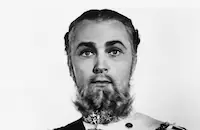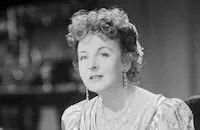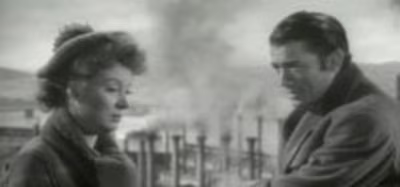The Swan

Brief Synopsis
Cast & Crew
Charles Vidor
Grace Kelly
Alec Guinness
Louis Jourdan
Agnes Moorehead
Jessie Royce Landis
Film Details
Technical Specs

Synopsis
In the town of Kissmiskolcz in Central Europe during 1910, Princess Beatrix heads a family of exiled royals desperate to return to the good graces of the current ruling family, led by Queen Maria Dominika. Dominika's son, bachelor Prince Albert, has recently completed his tour of Europe's eligible young ladies and now telegrams that he is coming to Kissmiskolcz, propelling Beatrix into a frenzy of activity as she tries to ensure that he fall in love with¿and marry¿her daughter Alexandra. After summoning her brother Carl, now a monk named Father Hyacinth, Beatrix, with her aunt Symphorosa, orders tutor Prof. Nicholas Agi to keep her sons George and Arsene out of sight and lectures Alexandra on the myriad ways to gain Albert's affections. Alexandra relieves her nervousness by fencing with Nicholas, who, nonplussed by the girl's cold manner, teaches her the arts of feinting. The whole household bustles to ready the estate for the prince's arrival, but when Albert comes, he retires straight to the bedroom and sleeps through two lavishly prepared meals.
The family waits impatiently for his entrance, and finally Albert joins them in the salon, where Beatrix hurries everyone out so Albert and Alexandra can be alone. Alexandra, whom her late father nicknamed "The Swan" for her cool beauty and pride, cannot warm up to the frivolous, sophisticated prince, and their stilted interaction ends after she flinches when he touches her hand. Unwilling to accept defeat, Beatrix arranges Albert's schedule over the next few days to include as much exposure as possible to Alexandra, but Albert prefers playing ball with Nicholas and the boys, and with the help of his aide, Capt. Wunderlich, eludes Beatrix and Alexandra. Despite her daughter's chagrin, Beatrix remains determined to ensnare Albert, and so before the ball planned for his last evening, commands Alexandra to invite Nicholas as her guest, hoping this will pique Albert's interest and jealousy. Although both women feel that Nicholas is beneath them, when Alexandra worries about stooping to such humiliating tactics, Beatrix assures her that she attracted Alexandra's father in a similar manner and that Nicholas is "nearly as much one of God's creatures" as are they.
The ball commences with a great deal of pomp, but when dancing begins, Albert first asks Beatrix to join him, then retreats to play bass with the musicians. Hurt, Alexandra agrees to dance with Nicholas, and as he twirls her expertly around the dance floor, his deep regard for her begins to melt her reserve. When she spots Albert with the band, however, Alexandra, mortified, races out of the ballroom and borrows a carriage. Nicholas runs after her and accompanies her to a nearby lake, where he showers her with heartfelt adulation, likening her to a mirage that is too beautiful to describe. The sheltered princess is overwhelmed by the young man's ardor and insists they return to the estate, where Albert has, as hoped, become intrigued by the couple's absence, and is hiding in a salon so he can drink brandy. Outside, Nicholas pledges his love to Alexandra and asks why she is no longer curt and officious toward him, and she sadly reveals the truth behind his invitation to the ball. Although she begs for his forgiveness, Nicholas is incensed and cannot accept her apology. Alexandra runs inside, only to find herself in the salon with Albert, followed by Nicholas. Nicholas' anger causes him to lash out at Albert, who is at first delighted to see both the tutor and the princess agitated and passionate, for once.
While Nicholas trades barbed quips with Albert about each other's social standing, he also downs his first-ever glasses of wine, and Alexandra follows suit. Beatrix, Carl and Symphorosa join them and listen in horror, causing Beatrix to swoon and insist that Albert take her upstairs. Carl lightly chastises Nicholas, who, unable to contain his anger, leaves to confront Albert. Alexandra cries in Carl's arms, but when he asks her how she likes the turn of events, she replies, still weeping, "I like it very much," and admits her attraction to Nicholas. After calling Nicholas back, Carl leaves the two alone, and the tutor soon coaxes a kiss from Alexandra. Just then, Albert re-enters and reproaches Nicholas for his impertinence, calling him an "insolent upstart." When Alexandra sees that Nicholas is about to respond in anger, thus putting himself in danger, she stops him with a kiss. Although Albert, realizing where Alexandra's affections lie, apologizes, Nicholas misinterprets the kiss as one of pity, and stalks out.
The next day, Dominika arrives at the estate and sweeps regally into Beatrix's room, where Beatrix is hiding under the covers, fearful of the queen learning that her son was thrown over for a tutor. Albert expertly manipulates his mother, however, soon convincing her that true love deserves applause and that Nicholas should go unpunished. Meanwhile, Alexandra sneaks into Nicholas' room and, seeing him packed to leave, asks to go with him. Distrustful, Nicholas declares that she cannot leave the shelter of her family and was mistaken in her attraction to him.
,br>
Carl finds the two and, approving of Nicholas' decision, brings them to Albert, who privately encourages them to reconcile, despite his emerging feelings for Alexandra and the probable family retribution. Nicholas refuses, however, and leaves the estate. While Alexandra watches his carriage ride off, Albert gently reminds her that, as The Swan, she is perfection while gliding on a lake but awkward once onshore, where the rest of the world dwells. Realizing she must remain silent, majestic and unable to fly, Alexandra turns solemnly to Albert and asks him to take her in to meet the queen, her future mother-in-law.

Director

Charles Vidor
Cast

Grace Kelly

Alec Guinness

Louis Jourdan

Agnes Moorehead

Jessie Royce Landis

Brian Aherne

Leo G. Carroll

Estelle Winwood
Van Dyke Parks
Christopher Cook

Robert Coote

Doris Lloyd
Edith Barrett
Jenifer Raine
Arthur Lovejoy
Paul Gillis
Stan Fraser
John Sheffield
Michael Ferris
Mac Douglas
Gene Coogan
Raoul Freeman
Ottola Nesmith
Leslie Denison
David Thursby
Virgil Sturgill
Harry Joe Canutt
Jean Heremans
Donald Remer
Dawn Richards
Lou Smith
Edith Motridge
Don Anderson
Brig. Gen. Hayne Davis Boyden
Crew
Ned Belford
Jim Brock
Ridgeway Callow
Eric Carpenter
John Dighton
Randall Duell
John Dunning
Cedric Gibbons
Henry Grace
Sydney Guilaroff
Charles K. Hagedon
Jean Heremans
Herb Hirst
Darryl Hollenbeck
Hubert Jansen
Bronislau Kaper
Count Carl Lonyay
Jay Marchant
Dr. Wesley C. Miller
John Pasternak
Bob Relyea
Helen Rose
Joseph Ruttenberg
Dore Schary
Robert Surtees
Jack Swain
William Tuttle
Edwin B. Willis

Photo Collections
Videos
Movie Clip





Trailer
Hosted Intro
Film Details
Technical Specs

Articles
The Swan
The Swan, a play by Hungarian playwright Ferenc Molnar, was a hit on Broadway in the 1920's. It had been made into a film with Lillian Gish, called One Romantic Night (1930). Grace Kelly had played the part of Princess Alexandra in a television version, before she went to Hollywood. In the summer of 1955, Kelly and MGM couldn't agree on what her next film would be...and suddenly, the actress was very eager to again play the princess whose destiny it is to marry a prince and glide through life "like a proud white swan...so dignified, so silent, so regal."
That spring, Kelly had been on the French Riviera for the Cannes Film Festival. A French magazine arranged a photo shoot with Prince Rainier at his palace in nearby Monaco. After that first meeting, the couple began to correspond secretly. So maybe a possible future with Rainier was on Kelly's mind when she suggested The Swan as her next project. Shooting began in late summer, with Biltmore House near Asheville, North Carolina standing in for the palatial home of European royalty. The house, built by George Vanderbilt in the 1890's, is a replica of a French chateau, and was then the largest mansion in the United States. Kelly seemed quite at home in the opulent surroundings.
The Swan wrapped production just before Christmas, and Kelly left to spend the holidays with her family in Philadelphia. Prince Rainier visited the Kellys, and by the end of his visit, the couple was engaged. MGM took full advantage of the publicity when it released The Swan to coincide with the royal wedding in the spring. Helen Rose, who had designed the costumes for the film, created Kelly's wedding gown as a gift from the studio. Although High Society would be released later, The Swan is actually the final Hollywood film Grace Kelly made. And it's a fitting "swan song" for the regal star who became Her Serene Highness, Princess Grace of Monaco.
Director: Charles Vidor
Producer: Dore Schary
Screenplay: John Dighton, based on the play by Ferenc Molnar
Editor: John Dunning
Cinematography: Joseph Ruttenberg, Robert Surtees
Art Direction: Cedric Gibbons, Randall Duell
Music: Bronislau Kaper
Principal Cast: Grace Kelly (Princess Alexandra), Alec Guinness (Prince Albert), Louis Jourdan (Dr. Nicholas Agi), Agnes Moorehead (Queen Maria Dominika), Jessie Royce Landis (Princess Beatrix), Brian Aherne (Father Hyacinth), Estelle Winwood (Symphorosa).
C-109m. Letterboxed. Closed captioning.
by Margarita Landazuri

The Swan
Quotes
Your father used to call you his swan, so I am told. I think that's a good thing to remember. Think what it means to be a swan. To glide like a dream on the smooth surface of the lake, and never go to the shore. On dry land, where ordinary people walk, the swan is awkward, even ridiculous. When she waddles up the bank she painfully resembles a different kind of bird, n'est-ce-pas?- Prince Albert
A goose.- Princess Alexandra
I'm afraid so. And there she must stay, out on the lake; silent, white, majestic. Be a bird, but never fly; know one song but never sing it until the moment of death. And so it must be for you, Alexandra. Cool indifference to the staring crowds along the bank. And the song? Never.- Prince Albert
Trivia
Notes
According to a July 1955 Hollywood Reporter news items, Rex Harrison was originally set to star in The Swan as "Prince Albert," contingent upon his being able to leave the theater production of Bell, Book and Candle six weeks early. In August 1955, Hollywood Reporter announced that Joseph Cotten had been offered the role. The film marked Alec Guinness' first feature to be shot in America.
The film was based on Ferenc Molnár's 1914 Hungarian play that had been produced several times on Broadway under its English-language title of The Swan. The first Broadway production of the play was staged on October 23, 1923. Grace Kelly had appeared in the CBS television production of The Swan on June 9, 1950. The picture was shot mostly on location in North Carolina, at the 1895 Biltmore Estate of George W. Vanderbilt in Asheville and at Lake Junaluska. Press materials note that an authentic 1888 locomotive, named the A. J. Cromwell, was shipped in from Baltimore, MD for the scene in which Albert arrives. Some interiors were shot at the M-G-M studio. The picture's fictional village was named Kissmiskolcz, after director Charles Vidor's Hungarian birthplace. As noted in a June-July 1956 Films in Review news item, director of photography Joseph Ruttenberg shot all the location scenes in North Carolina. After a few weeks of work back at the studio, however, he fell ill, after which Robert Surtees took over all the interior scenes. According to a modern source, Bess Flowers appeared in the film as a ball attendee, and Angela Blue served as the picture's choreographer.
As confirmed in modern sources, Kelly met Prince Rainier Grimaldi of Monaco at the 1954 Cannes Film Festival. The two corresponded for months, during which M-G-M, hoping to capitalize on their romance, offered Kelly the role of "Princess Alexandra." As soon as production wrapped on The Swan in December 1955, Rainier visited Kelly at her family home in Philadelphia, and they announced their engagement on January 5, 1956. The studio held the release of The Swan to correspond with Kelly's wedding day, on April 18, 1956. As noted in a modern source, "Any resemblance between MGM's Ruritanian romance and the much publicized real-life fairy-tale marriage was anything but coincidental, despite the studio's ludicrous token denial." Kelly made only one more feature film, M-G-M's High Society, which was shot prior to her marriage. Prince Rainier and his subjects disapproved of their princess being involved in filmmaking. Kelly's marriage was, according to some biographical sources, an unhappy one. After three children and a lifetime of charity work, she died on September 13, 1982 in a car accident, at the age of fifty-two.
The reviews were unanimously favorable toward The Swan, and Kelly in particular. The Hollywood Reporter critic stated, "She will be the girl who stood right on the threshold of becoming the next Garbo." The Los Angeles Times reviewer commented, "If by any chance The Swan should be Grace Kelly's final picture, then this remarkably successful star will have attained a lustrous culmination to her movie career."
The Molnár play had previously been filmed in 1925 by Famous Players-Lasky, directed by Dimitri Buchowetzki and starring Frances Howard and Adolphe Menjou; and in 1930 by United Artists under the title One Romantic Night, directed by Paul L. Stein and starring Lillian Gish and Rod La Rocque (see AFI Catalog of Feature Films, 1921-30).

Miscellaneous Notes
Released in United States Spring April 1956
Final screen appearance for Grace Kelly.
CinemaScope
Released in United States Spring April 1956
















